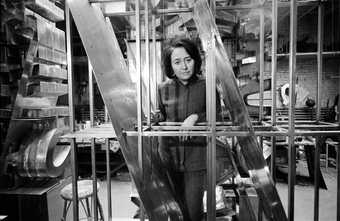Born 1933 in Athens, Greece, where she died in 2013.

Chryssa in her Brooklyn studio with The Gates to Times Square, c.1965
© The estate of Chryssa Vardea
Photo © Howard Harrison
Chryssa Vardea-Mavromichali was a Greek-born American sculptor best known for her monumental assemblages combining neon, bronze, aluminium, plaster, wood, canvas and paint as well as found objects, which prefigured both pop art and minimalism. Vardea studied in Paris and San Francisco, and in 1955 moved to New York, finding inspiration in the spectacle of the advertising neon signs of Times Square. Her interest in communication and the use of letters was first expressed through small baked-clay tablets entitled Cycladic Books 1955, followed by tablets and plaques with single letters, or variations on letter forms. Using neon since 1962, Vardea was one of the first artists to transform it from an advertising tool into an art material.
It was the same interest in the written word that inspired Chryssa Vardea’s most ambitious, monumental work, The Gates to Times Square (also known as ‘The Gates’), which was realised between 1964 and 1966. The work is Vardea’s homage to her experience of New York, to popular culture, advertising and mass communication. Consisting of two monumental letter As, incorporating fragments of commercial signs, the just under one-metresquare stainless steel, Plexiglas and neon sculpture invites visitors to walk through it, becoming physically immersed in the pale blue neon light with changing intensity and rhythm. Study for Gates No. 4 1967 is one of sixteen sculptures entitled Studies for Gates, which the artist produced both before and after the completion of the main work itself. The work takes a fragment of the monumental work, resembling the letter S, repeating it sixteen times, in eight double sets of blue neon lights, which light up in sequence.
Lina Džuverović
September 2015
